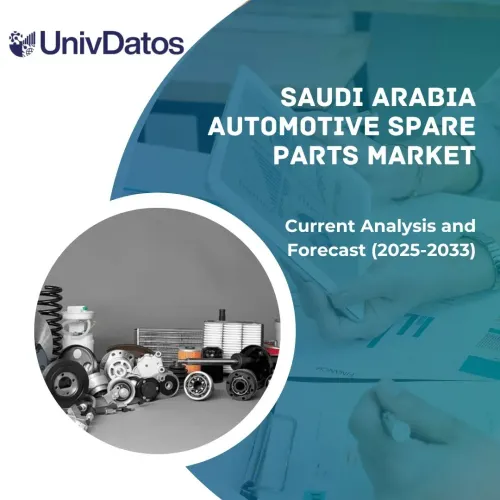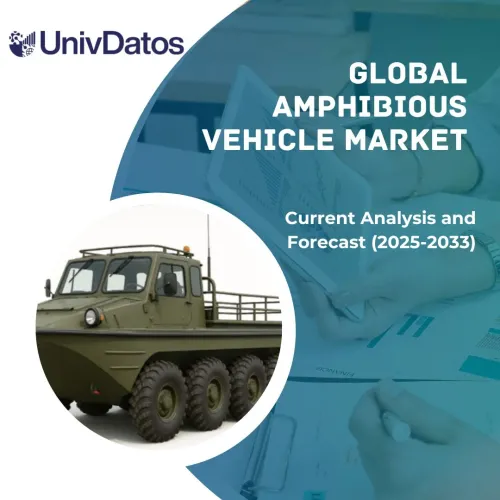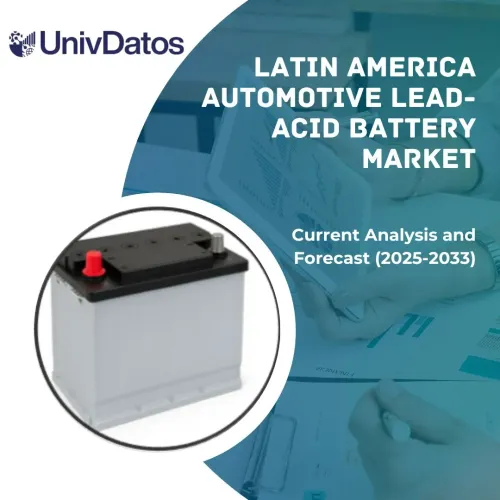- Inicio
- Acerca de nosotros
- Industria
- Servicios
- Leyendo
- Contáctenos
Mercado de Fusión de Sensores: Análisis Actual y Pronóstico (2023-2030)
Énfasis en Tipo (Sensor de radar, Sensor de imagen, IMU, Sensor de temperatura, Otros; Tecnología (MEMS, NO MEMS); Sector vertical (Automotriz, Sanitario, Eléctrico y Electrónico, Militar y Defensa, y Militar y Defensa); y Región/País
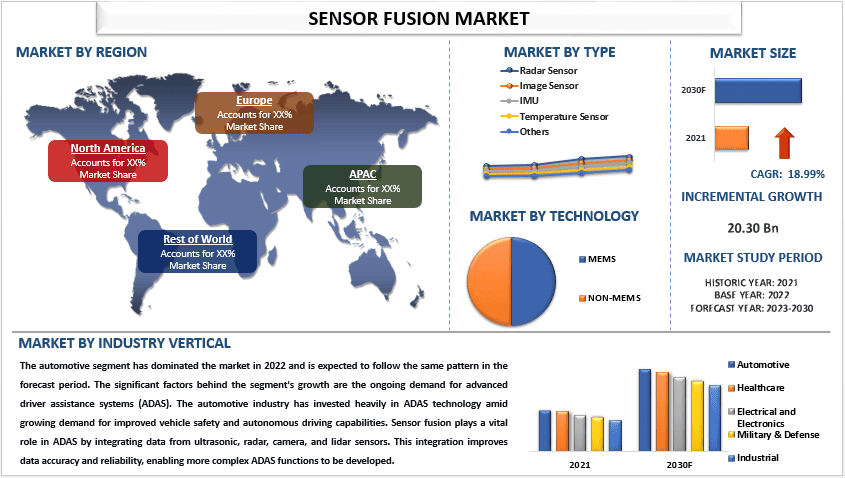
El mercado de Fusión de Sensores se valoró en USD 6.72 mil millones en 2022 y se espera que crezca a una CAGR del 18.99% de 2023 a 2030. El aumento de las ventas de teléfonos inteligentes a nivel mundial contribuye directamente a la expansión del mercado de fusión de sensores. A medida que los teléfonos inteligentes continúan evolucionando, los productores buscan constantemente enfoques para mejorar la experiencia del consumidor mediante la incorporación de múltiples sensores en sus dispositivos. La fusión de sensores, que incluye la combinación de datos de múltiples sensores para mejorar la precisión y la confiabilidad, desempeña un papel importante para permitir numerosas características y funcionalidades de los teléfonos inteligentes. Por ejemplo, la integración de sensores de acelerómetro, giroscopio y magnetómetro permite un monitoreo preciso del movimiento, lo que facilita experiencias de juego inmersivas y programas superiores de monitoreo de la salud. Además, la fusión de sensores de cámara con sensores de profundidad o tecnología LiDAR permite capacidades avanzadas de realidad aumentada (AR), creando una combinación continua de experiencias digitales y del mundo real. Por ejemplo, en 2022, según el informe publicado por SellCell, el número total de teléfonos inteligentes vendidos en el año 2009 fue de 172.38 millones, alcanzó los 1510.3 millones en 2021 y se espera que alcance los 1676.1 millones en 2027. Por lo tanto, la creciente demanda de teléfonos inteligentes impulsa la demanda del mercado de fusión de sensores en los próximos años.
Algunos de los principales actores que operan en el mercado incluyen Robert Bosch GmbH, ZF Friedrichshafen AG, Continental AG, NXP Semiconductor, Infineon Technologies, Denso Corporation, Renesas Electronics Corporation, Aptiv, TDK Corporation, ST Microelectronics. Estos actores han emprendido varias fusiones y adquisiciones junto con asociaciones para facilitar a los clientes productos/tecnologías innovadores y de alta tecnología.
Perspectivas presentadas en el informe
“Entre los tipos, el segmento de radar dominó el mercado en 2022”
Según el tipo, el mercado se divide en sensores de radar, sensores de imagen, IMU, sensores de temperatura y otros. El segmento de radar dominó el mercado en 2022 y se espera que muestre la misma tendencia en el período de pronóstico. Los sensores de radar se utilizan generalmente en la detección y el seguimiento de objetos en la aviación y otras industrias, especialmente en condiciones climáticas extremas donde la visibilidad es muy baja. Además, el sensor de radar se utiliza con precisión en el vehículo autónomo para detectar y rastrear peatones y otros obstáculos. Por lo tanto, la creciente industria de la aviación y la creciente adopción de vehículos autónomos satisfacen la demanda de sensores de fusión.
“Entre las tecnologías, el segmento MEMS es actualmente el líder del mercado en 2022”
Según la tecnología, el mercado se segmenta en MEMS y no MEMS. El segmento MEMS es actualmente el segmento líder y se espera que domine el segmento en el período de pronóstico. El principal factor para el crecimiento del segmento es la creciente demanda de dispositivos microelectrónicos debido a la creciente demanda de tecnologías digitales en la era actual, la creciente demanda de automatización en varias industrias de usuarios finales y el avance en las tecnologías. Además, los sensores MEMS se producen utilizando el proceso de fabricación por lotes y aprovechando las técnicas de semiconductores.
“Entre los verticales de la industria, el segmento automotriz dominó el mercado de fusión de sensores en 2022”
Según el vertical de la industria, el mercado se bifurca en automotriz, atención médica, eléctrica y electrónica, militar y defensa, e industrial. Entre estos, el segmento automotriz ha dominado el mercado en 2022 y se espera que siga el mismo patrón en el período de pronóstico. Los principales factores detrás del crecimiento del segmento son la demanda actual de sistemas avanzados de asistencia al conductor (ADAS). La industria automotriz ha invertido fuertemente en la tecnología ADAS en medio de la creciente demanda de una mayor seguridad vehicular y capacidades de conducción autónoma. La fusión de sensores desempeña un papel vital en ADAS al integrar datos de sensores ultrasónicos, de radar, de cámara y lidar. Esta integración mejora la precisión y la confiabilidad de los datos, lo que permite desarrollar funciones ADAS más complejas.
“Asia Pacífico acelera la CAGR más alta para el mercado de fusión de sensores en 2022”
La región de Asia Pacífico exhibiría la CAGR más alta durante 2023-2030 debido a la creciente demanda de vehículos autónomos, el surgimiento de la digitalización en países como India y China, y las crecientes inversiones para construir ciudades inteligentes. Uno de los principales factores que impulsan el crecimiento del mercado de fusión de sensores de Asia Pacífico es la creciente demanda de ventas de vehículos autónomos en la región, particularmente en Japón y China. La industria de la aviación también ha experimentado una revolución y la digitalización ha interrumpido los enfoques tradicionales de la aviación, mejorando la protección, el rendimiento y la experiencia del pasajero. La fusión de sensores también desempeña una función importante aquí. Al combinar datos de varios sensores, incluidos los radares meteorológicos, los sistemas de aviónica y los sistemas de vigilancia, las aerolíneas pueden tomar decisiones informadas, detectar posibles peligros y mejorar el reconocimiento situacional estándar. Por ejemplo, en 2023, Air India, la aerolínea propiedad de Tata Group, realizó recientemente un pedido masivo de 470 aviones a los fabricantes de aviones Airbus y Boeing en un acuerdo por valor de USD 68 mil millones. Además, el auge de las ciudades inteligentes dentro de la región de Asia Pacífico ha impulsado la demanda de tecnología de fusión de sensores. Las tareas de ciudades inteligentes tienen como objetivo aprovechar la digitalización y el IoT (Internet de las cosas) para mejorar la vida urbana, la sostenibilidad y la movilidad. Los sensores desempeñan un papel fundamental en la recopilación de información sobre el tráfico, la calidad del aire, la infraestructura y la seguridad pública. Al utilizar los datos de diversos sensores, las autoridades pueden obtener información en tiempo real, optimizar la asignación de recursos y mejorar la excelente calidad de vida en estas ciudades. Por ejemplo, en febrero de 2023, el gobierno indio asignó USD 1717.36 millones a su misión de ciudades inteligentes y anunció el establecimiento de un fondo de desarrollo de infraestructura urbana para pueblos más pequeños y reformas en la planificación urbana y el impuesto sobre la propiedad para mejorar la sostenibilidad. Por lo tanto, la región de Asia-Pacífico está siendo testigo de un crecimiento significativo en el mercado de sensores de fusión y se espera que actúe de la misma manera en el período de pronóstico.
Cobertura del informe del mercado de fusión de sensores
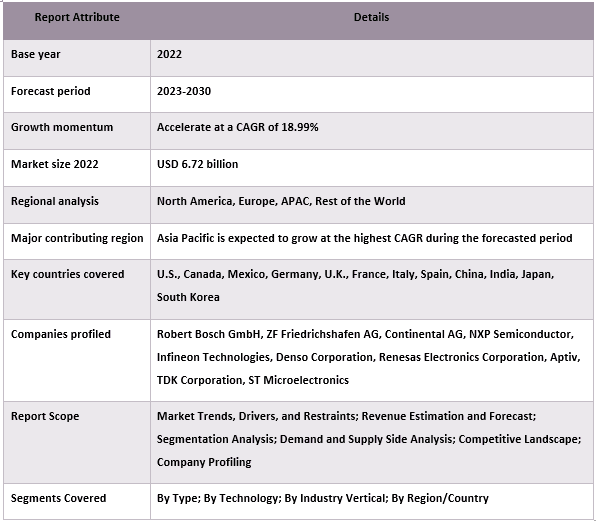
Razones para comprar este informe:
- El estudio incluye análisis de dimensionamiento y previsión del mercado validados por expertos clave autenticados de la industria.
- El informe presenta una revisión rápida del desempeño general de la industria de un vistazo.
- El informe cubre un análisis en profundidad de los pares prominentes de la industria con un enfoque principal en las finanzas comerciales clave, las carteras de productos, las estrategias de expansión y los desarrollos recientes.
- Examen detallado de los impulsores, las restricciones, las tendencias clave y las oportunidades que prevalecen en la industria.
- El estudio cubre exhaustivamente el mercado en diferentes segmentos.
- Análisis profundo a nivel regional de la industria.
Opciones de personalización:
El mercado global de fusión de sensores se puede personalizar aún más según los requisitos o cualquier otro segmento del mercado. Además de esto, UMI entiende que puede tener sus propias necesidades comerciales, por lo tanto, no dude en conectarse con nosotros para obtener un informe que se adapte completamente a sus requisitos.
Tabla de contenido
Metodología de Investigación para el Análisis del Mercado de Fusión de Sensores (2023-2030)
El análisis del mercado histórico, la estimación del mercado actual y la previsión del mercado futuro del mercado global de fusión de sensores fueron los tres pasos principales que se llevaron a cabo para crear y analizar la adopción de la fusión de sensores en las principales regiones del mundo. Se llevó a cabo una exhaustiva investigación secundaria para recopilar las cifras históricas del mercado y estimar el tamaño actual del mercado. En segundo lugar, para validar estas perspectivas, se tomaron en consideración numerosos hallazgos y suposiciones. Además, también se realizaron exhaustivas entrevistas primarias con expertos de la industria en toda la cadena de valor del mercado global de fusión de sensores. Tras la suposición y la validación de las cifras del mercado a través de entrevistas primarias, empleamos un enfoque de arriba hacia abajo/de abajo hacia arriba para pronosticar el tamaño completo del mercado. Posteriormente, se adoptaron métodos de desglose del mercado y triangulación de datos para estimar y analizar el tamaño del mercado de los segmentos y subsegmentos de la industria a la que pertenece. La metodología detallada se explica a continuación:
Análisis del Tamaño Histórico del Mercado
Paso 1: Estudio en Profundidad de Fuentes Secundarias:
Se llevó a cabo un estudio secundario detallado para obtener el tamaño histórico del mercado de la fusión de sensores a través de fuentes internas de la empresa, como informes anuales y estados financieros, presentaciones de rendimiento, comunicados de prensa, etc., y fuentes externas, incluidos revistas, noticias y artículos, publicaciones gubernamentales, publicaciones de la competencia, informes del sector, bases de datos de terceros y otras publicaciones creíbles.
Paso 2: Segmentación del Mercado:
Después de obtener el tamaño histórico del mercado de la fusión de sensores, realizamos un análisis secundario detallado para recopilar información histórica del mercado y compartirla para diferentes segmentos y subsegmentos para las principales regiones. Los principales segmentos incluidos en el informe son el tipo de producto, el tipo de coche, la aplicación y el canal de distribución. Además, se realizaron análisis a nivel de país para evaluar la adopción general de modelos de prueba en esa región.
Paso 3: Análisis de Factores:
Después de adquirir el tamaño histórico del mercado de diferentes segmentos y subsegmentos, realizamos un análisis de factores detallado para estimar el tamaño actual del mercado de la fusión de sensores. Además, realizamos un análisis de factores utilizando variables dependientes e independientes, como el tipo, la tecnología y la vertical de la industria del mercado de la fusión de sensores. Se llevó a cabo un análisis exhaustivo de los escenarios de oferta y demanda teniendo en cuenta las principales asociaciones, fusiones y adquisiciones, la expansión empresarial y los lanzamientos de productos en el sector del mercado de la fusión de sensores en todo el mundo.
Estimación y Previsión del Tamaño Actual del Mercado
Tamaño Actual del Mercado: Basándonos en la información práctica de los 3 pasos anteriores, llegamos al tamaño actual del mercado, los actores clave en el mercado global de fusión de sensores y las cuotas de mercado de los segmentos. Todos los porcentajes de participación requeridos y los desgloses del mercado se determinaron utilizando el enfoque secundario mencionado anteriormente y se verificaron a través de entrevistas primarias.
Estimación y Previsión: Para la estimación y previsión del mercado, se asignaron ponderaciones a diferentes factores, incluidos los impulsores y las tendencias, las restricciones y las oportunidades disponibles para las partes interesadas. Después de analizar estos factores, se aplicaron técnicas de previsión relevantes, es decir, el enfoque de arriba hacia abajo/de abajo hacia arriba, para llegar a la previsión del mercado para 2030 para diferentes segmentos y subsegmentos en los principales mercados a nivel mundial. La metodología de investigación adoptada para estimar el tamaño del mercado abarca:
- El tamaño del mercado de la industria, en términos de ingresos (USD) y la tasa de adopción del mercado de la fusión de sensores en los principales mercados a nivel nacional
- Todos los porcentajes de participación, divisiones y desgloses de los segmentos y subsegmentos del mercado
- Actores clave en el mercado global de fusión de sensores en términos de productos ofrecidos. Además, las estrategias de crecimiento adoptadas por estos actores para competir en el mercado de rápido crecimiento
Validación del Tamaño y la Cuota de Mercado
Investigación Primaria: Se llevaron a cabo entrevistas en profundidad con los Líderes de Opinión Clave (KOL) incluyendo Ejecutivos de Alto Nivel (CXO/VPs, Jefe de Ventas, Jefe de Marketing, Jefe de Operaciones, Jefe Regional, Jefe de País, etc.) en las principales regiones. Los hallazgos de la investigación primaria se resumieron y se realizó un análisis estadístico para probar la hipótesis establecida. Los aportes de la investigación primaria se consolidaron con los hallazgos secundarios, convirtiendo así la información en información práctica.
División de los Participantes Primarios en Diferentes Regiones
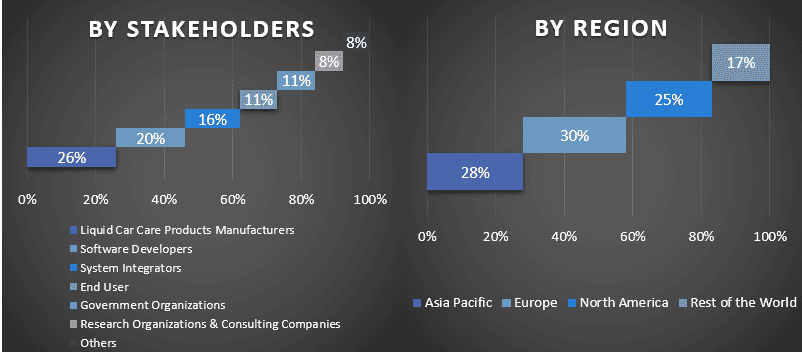
Ingeniería de Mercado
Se empleó la técnica de triangulación de datos para completar la estimación general del mercado y llegar a cifras estadísticas precisas para cada segmento y subsegmento del mercado global de fusión de sensores. Los datos se dividieron en varios segmentos y subsegmentos después de estudiar varios parámetros y tendencias en las áreas de la solución, la aplicación y el usuario final en el mercado global de fusión de sensores.
El objetivo principal del Estudio del Mercado Global de Tanques de Almacenamiento
Las tendencias actuales y futuras del mercado global de fusión de sensores se identificaron en el estudio. Los inversores pueden obtener información estratégica para basar su criterio para las inversiones en el análisis cualitativo y cuantitativo realizado en el estudio. Las tendencias actuales y futuras del mercado determinaron el atractivo general del mercado a nivel regional, proporcionando una plataforma para que el participante industrial explote el mercado sin explotar para beneficiarse de una ventaja de ser el primero en actuar. Otros objetivos cuantitativos de los estudios incluyen:
- Analizar el tamaño actual y previsto del mercado de la fusión de sensores en términos de valor (USD). Además, analizar el tamaño actual y previsto del mercado de diferentes segmentos y subsegmentos
- Los segmentos en el estudio incluyen áreas del tipo, la tecnología y la vertical de la industria
- Definir y analizar el marco regulatorio para la industria de la fusión de sensores
- Analizar la cadena de valor involucrada con la presencia de varios intermediarios, junto con el análisis de los comportamientos de los clientes y la competencia de la industria
- Analizar el tamaño actual y previsto del mercado de la fusión de sensores para la región principal
- Los principales países de las regiones estudiadas en el informe incluyen Asia Pacífico, Europa, América del Norte y el resto del mundo
- Perfiles de empresas del mercado de la fusión de sensores y las estrategias de crecimiento adoptadas por los participantes del mercado para mantenerse en el mercado de rápido crecimiento
- Análisis regional profundo de la industria
Relacionados Informes
Los clientes que compraron este artículo también compraron

